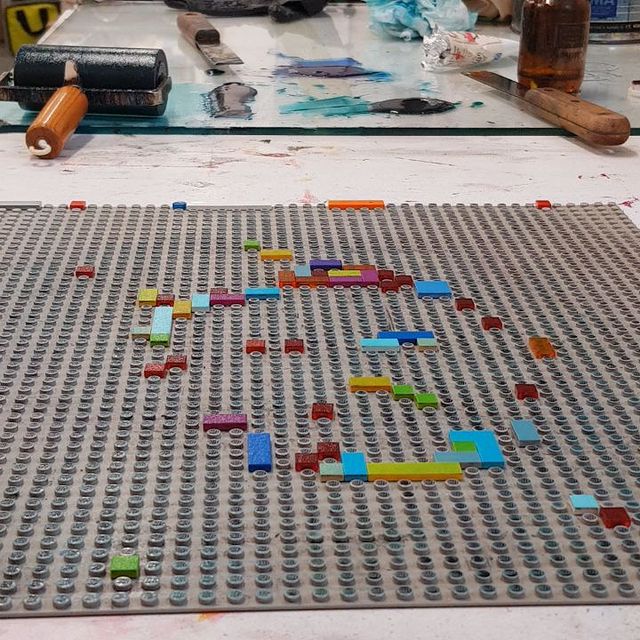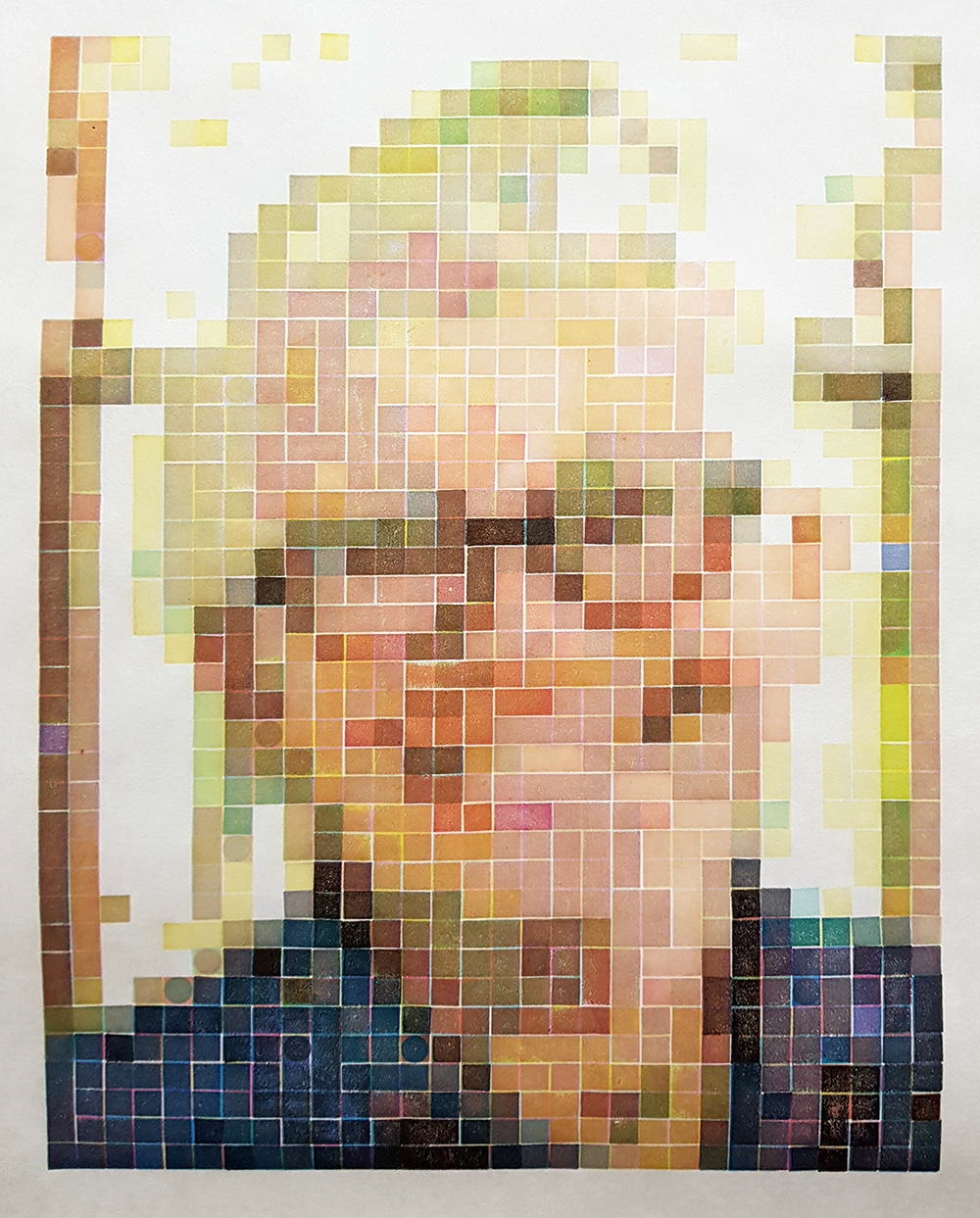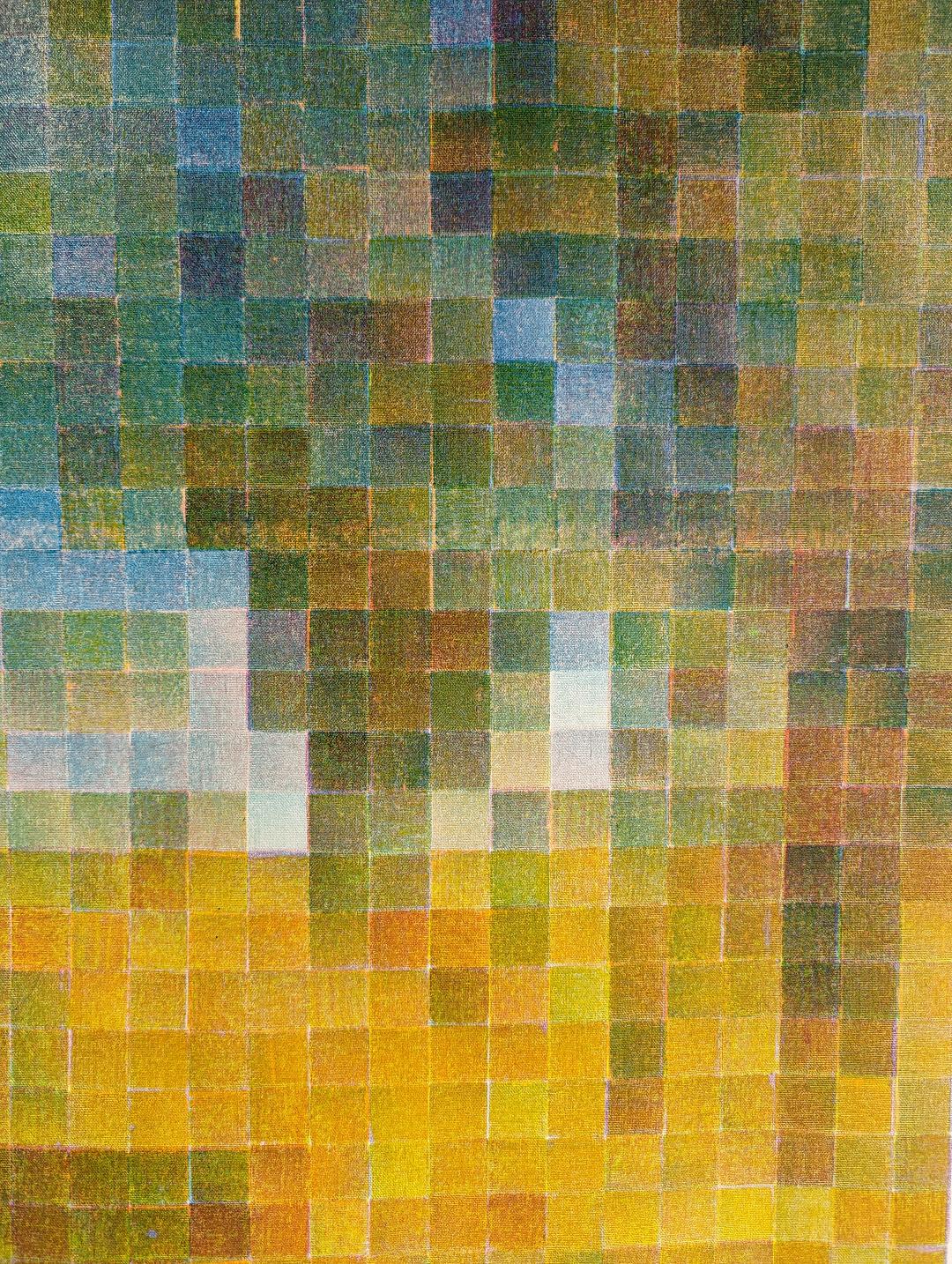



From top: Peter McLean
Distant Friends – Alison, 2021, relief print from Lego on kozo paper, 32 x 24 cm, edition of 4.
Q: What were some of the foundation ideas for this exhibition project?
A: This project began from a series of ‘what-ifs’ and thought experiments, but with the arrival of COVID-19 lockdowns, and a successful application for funding from artsACT it quickly morphed into a fully committed project three years in the execution.
Beginning with ‘what if there were some way of creating a re-usable relief print matrix’ – I somehow ended up at the idea of using Lego pieces. I later discovered that Lego prints are ‘a thing’ but I haven’t come across anyone else doing them quite like this. I have been interested in adapting CMYK colour systems to relief print for a while and another thread of investigation is the nexus between realism, abstraction and reproduction. I chose portraits as the subject to pull all this together, and more specifically, portraits of friends that are a pixelated reproduction of their profile photos from social media. This choice was driven by the way our brains are so keenly adapted to recognising faces. Faces are therefore one of the most easily recognised subjects despite the significant distortions that my process creates and so the sense of amazement at the different experience of the work depending on viewing distance is most apparent. These ideas were all coalescing just as the COVID-19 pandemic began, and face to face interactions with friends suddenly became out of reach. So, it seemed fitting to dwell on the opportunities and deficiencies of online interactions as a substitute, and what it means to see someone’s face through digital reproduction only.
Q: How did the artwork selection take place?
A: The core of the exhibition is the 18 portraits in the Distant Friends series. When Distant Friends was shown in Brisbane last year (Impress Printmakers Gallery) I included older works that also explored CMYK relief prints to put the portraits into context of a broader practice. For this version of the show at Megalo, I have decided to look forward and included the first prints from the next project I have just started on. These continue the pixel theme, but now with a different printing system, using individual wood blocks creating a larger pixel than the Lego prints, further enhancing the sense of distortion and abstraction. These are derived from landscape images and are printed onto canvas and stretched.
Q: How does the exhibition manifest – what do visitors experience?
A: The exhibition is quite formal and conventional in general appearance, with the framed portraits arrayed in a row around the space. The larger landscape works on canvas act as punctuation at the ends of the main walls. The positioning of the canvas works can imply they are enlarged sections of the adjacent portraits. The real surprise comes as the viewer moves closer to the work and the pixelation and abstractness of the work overcomes the recognisable portraits that are the general first impression. At this point they take on something of a digital quality. Further close inspection soon dispels that as the many clues to the true material nature of the work become evident. An example is the tiny hints of the separate unlayered CMYK colours around the edges of each pixel. This arises because the Lego tiles have a slight bevel on the edges, which leave a tiny white line between pixels – except not only 1×1 tiles were used, so these lines are sometimes printed when a larger tile is used. So the lines are often not white, but also usually not containing all the layers of the adjacent pixel. The keen observer will also notice that while the image is mostly composed of square pixels, there are the occasional circle and also small stripes.
Q: What are some of the key works and what subject matter do they deal with?
A: The Distant Friends series that makes up the bulk of the show is pretty tight in its parameters, and so I wouldn’t say there are any key works – they all work together to build the series. That said, I do of course have a few favourites, that seem to work particularly well. One of those is Distant Friends – Greg, partly because it is an example where there was quite a lot of alteration between the design stage and the final outcome. All the Distant Friends prints start with a photograph (‘stolen’ from the internet) and then a small number of Photoshop processes to produce a mock-up, a kind of template that instructs me how to place the Lego tiles on the baseplate to build each ‘block’ to print from. The mock-ups contain sixteen layers – being four different tones of each of the four colours (cyan, magenta, yellow, black). But then when I come to first build and then print each of these layers, various things happen. I sometimes fuse a couple of layers together, just to save a little time, if one of them doesn’t hold much information and I think I can get away with it. Sometimes there are small glitches, errors in building the blocks that I don’t notice in time. The sticky ink often lifts a tile off the baseplate – I will try to figure out where it has come from and rectify it, but if I can’t find where it came from quickly, or it keeps coming off again during proofing, I let it be, and so that will create a pixel the ‘wrong’ colour. But with Greg , it was looking so fresh and lovely with just the magenta and the first couple of layers of cyan – I felt compelled to really mess with the template. The original background was dark and green – the tropical forest where Greg lives, but the final print leaves out the two darker tones of cyan the template would have suggested, some of the yellow too, and I left off the black entirely as well. Which of course is usually the ‘key’, that pulls all the tone into proper alignment. The forest was gone, but instead the print was brighter, more colourful, and kind of ‘disco’. Perfect for Greg.
Q: What is it about the printmaking experience that you most appreciate?
A: I take the ‘craft’ of printmaking very seriously. By which I mean the fine tuning and attention to detail of all the technical aspects, the getting the ink just so etc etc, in the service of reliably and consistently transferring the information from the matrix to the paper. I also often (and Distant Friends is a prime example) create projects that have an aspect of psudo-science about them – logical sequences, rules-based decision making, procedures to adhere to. On the other hand, the story above of creating Distant Friends – Greg, lets the cat out of the bag somewhat. What I love is when an aesthetic choice interjects, when the self-made rules are broken, but overall everything still seems to be in order. I love the challenge of striving for perfect reproduction using such basic means as a bit of wood and some ink, knowing that it is the very imperfections of the handmade that give me satisfaction. I enjoy printmaking that sits in that gap, somewhere between mechanical reproduction and the spontaneously autographic. While the Distant Friends series relied heavily on the digital for image sourcing and creating the pixelated design, it is important to me that it is handprinted. And looks it too – there are plenty of quirks and imperfections to distinguish them from a digital output.
Distant Friends is at Megalo Gallery, Canberra from 4 Feb-25 March
www.megalo.org/peter-mclean-distant-friends
—
Join the PCA and become a member. You’ll get the fine-art quarterly print magazine Imprint, free promotion of your exhibitions, discounts on art materials and a range of other exclusive benefits.





